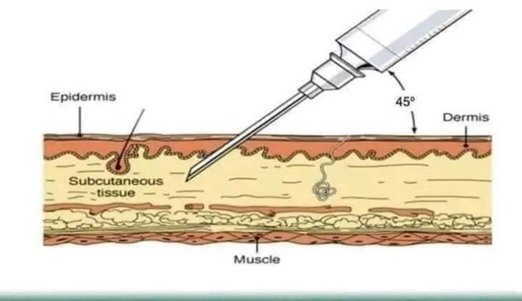A nurse is preparing to administer a subcutaneous injection to a client. Which of the following actions should the nurse plan to take?
Cleanse the injection site with a circular motion.
Don sterile gloves prior to the injection.
Use the dominant hand to pinch the client's skin
Inject the medication at a 15° angle to the client's skin
The Correct Answer is A
A. Cleansing the injection site is important to reduce the risk of infection.

B. Sterile gloves are not typically required for administering subcutaneous injections unless there is a specific indication, such as when dealing with a client who has a compromised immune system or if there is potential for exposure to bodily fluids.
C. Pinching the skin can help in creating a fold where the needle can be inserted. However, there is no standard recommendation on which hand should be used.
D. Subcutaneous injections are typically administered at a 45-degree or 90-degree angle to the client's skin, depending on the amount of subcutaneous tissue present.
Nursing Test Bank
Naxlex Comprehensive Predictor Exams
Related Questions
Correct Answer is D
Explanation
D. Administering the injection in the love handles, 2 inches from the umbilicus. It is important not to remove the air bubble from the prefilled syringe, as it is designed to ensure the entire dose of medication is administered.
A. Enoxaparin should not be transferred into another syringe unless specifically instructed by the manufacturer or pharmacy guidelines. Pre-filled syringes are designed to deliver the correct dose accurately and safely.
B. It is important not to remove the air bubble from the prefilled syringe, as it is designed to ensure the entire dose of medication is administered.
C. A 30-degree angle is too shallow for subcutaneous injections and may result in the medication being deposited too close to the skin surface, potentially causing irritation or affecting absorption.
Correct Answer is ["2"]
Explanation
To administer a dose of 250 mg of amoxicillin when only 125 mg tablets are available, the nurse would need to give two tablets. This is because each tablet contains 125 mg, and two tablets would equal the required dose of 250 mg
Whether you are a student looking to ace your exams or a practicing nurse seeking to enhance your expertise , our nursing education contents will empower you with the confidence and competence to make a difference in the lives of patients and become a respected leader in the healthcare field.
Visit Naxlex, invest in your future and unlock endless possibilities with our unparalleled nursing education contents today
Report Wrong Answer on the Current Question
Do you disagree with the answer? If yes, what is your expected answer? Explain.
Kindly be descriptive with the issue you are facing.
